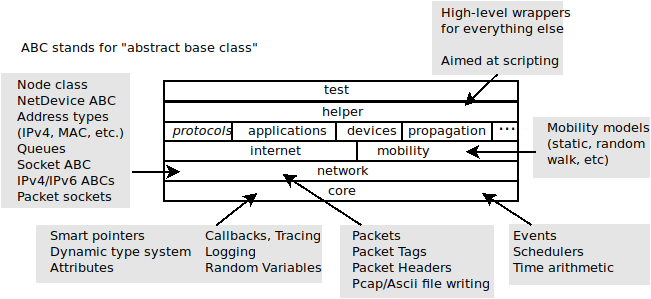Organization¶
This chapter describes the overall ns-3 software organization and the corresponding organization of this manual.
ns-3 is a discrete-event network simulator in which the simulation core and models are implemented in C++. ns-3 is built as a library which may be statically or dynamically linked to a C++ main program that defines the simulation topology and starts the simulator. ns-3 also exports nearly all of its API to Python, allowing Python programs to import an “ns3” module in much the same way as the ns-3 library is linked by executables in C++.

Software organization of ns-3¶
The source code for ns-3 is mostly organized in the src directory and
can be described by the diagram in Software organization of ns-3. We will
work our way from the bottom up; in general, modules only have dependencies
on modules beneath them in the figure.
We first describe the core of the simulator; those components that are
common across all protocol, hardware, and environmental models.
The simulation core is implemented in src/core. Packets are
fundamental objects in a network simulator
and are implemented in src/network. These two simulation modules by
themselves are intended to comprise a generic simulation core that can be
used by different kinds of networks, not just Internet-based networks. The
above modules of ns-3 are independent of specific network and device
models, which are covered in subsequent parts of this manual.
In addition to the above ns-3 core, we introduce, also in the initial portion of the manual, two other modules that supplement the core C++-based API. ns-3 programs may access all of the API directly or may make use of a so-called helper API that provides convenient wrappers or encapsulation of low-level API calls. The fact that ns-3 programs can be written to two APIs (or a combination thereof) is a fundamental aspect of the simulator. We also describe how Python is supported in ns-3 before moving onto specific models of relevance to network simulation.
The remainder of the manual is focused on documenting the models and
supporting capabilities. The next part focuses on two fundamental objects in
ns-3: the Node and NetDevice. Two special NetDevice types are
designed to support network emulation use cases, and emulation is described
next. The following chapter is devoted to Internet-related models,
including the
sockets API used by Internet applications. The next chapter covers
applications, and the following chapter describes additional support for
simulation, such as animators and statistics.
The project maintains a separate manual devoted to testing and validation of ns-3 code (see the ns-3 Testing and Validation manual).
